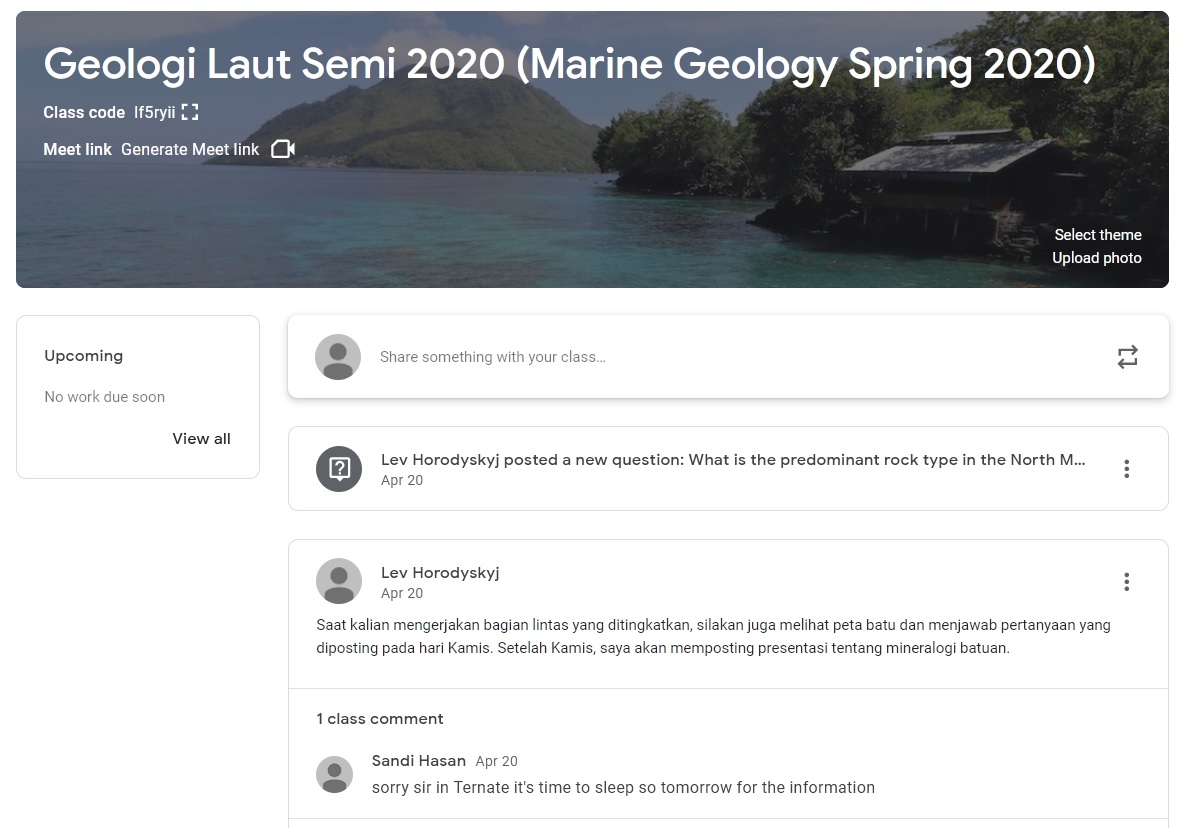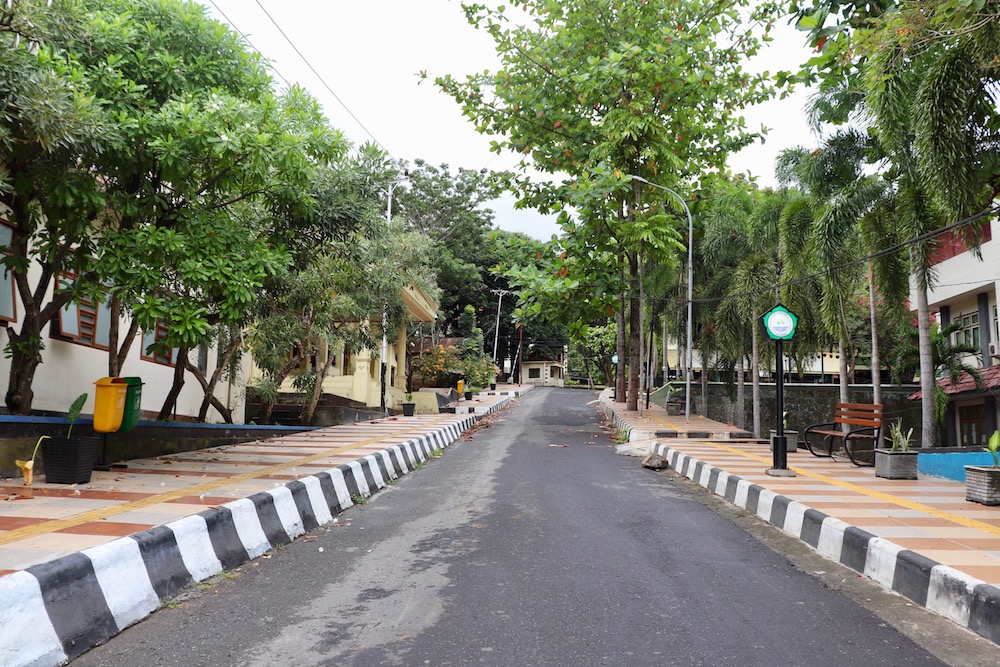Infrastructure Gap
My Fulbright field location, Khairun University in North Maluku, Indonesia, was a deliberate choice. When I initially applied for the program, I had intended to work on an island on the outskirts of mainstream Indonesian society, which tends to be centered around Jakarta and the island of Java where most of the population resides. My interest was in finding a challenging environment that was as different from my privileged American teaching environment as possible. In the last few years, I had grown disenchanted with how work that had been intended to empower teachers to transform their own classrooms was becoming more expensive, more exclusive, and more stressful to complete, making these digital teaching tools and approaches even more inaccessible than they had been a decade prior. But in the high-pressure production environment that had developed around me, where bandwidth was plentiful and more powerful computers arrived whenever they were required, it became difficult to think in terms other than more intense computational models, splashier simulators, and more complex learning designs. I found my mind boxed in and my creativity sapped. Hence my desire to find something radically different from the experiences that typified the last decade of my career.
My six-month Fulbright plan had been to spend a couple of months adjusting and learning the various educational, governmental, and societal systems in which I would be living and working. I had also wanted to explore the nearby islands to see how they compared to Ternate, which was the largest city in the region. As I would grow familiar with the system, I had brought low-powered computers, do-it-yourself tech kits, cheap drones, and old cameras that I could use to figure out the best ways to digitize science education for this region and its local challenges, working with my new colleagues and students. The hope was that by the time I left Indonesia in August at the end of my fellowship, I would have a completely different digital education architecture to work with that was at the opposite end of the spectrum of the high-end American digital education architecture that I was already quite familiar with and that did not easily translate into more challenging teaching environments even within the US.
Like most of the rest of the planet, those plans were thrown into ruin by the pandemic. Because it was a six-month program and I was only at the 1.5-month mark, I had barely familiarized myself with my new surroundings when I was forced to return home. Course digitization needed to be accelerated to a couple of weeks, which also overlapped with my chaotic evacuation back to the US. I was walking into this digitization with few previous interactions with the students (for one class we had only met three times, and for the other just once with six students because the university was already in the process of shutting down) and little to no understanding of the digital infrastructure of the region aside from my immediate experiences in Ternate. Additionally, there was no scholastic culture in creating, offering, or taking online science courses either with the teachers or the students. I was able to set up Google Classroom and post a few activities in the limited formats that Google Classroom allows, but those materials ran into a myriad of problems which included confusing translations, student unfamiliarity with asynchronous learning, digital literacy problems, time zone differences, poor connectivity, and for about half of my students no internet connectivity at all. One class is limping along on Google Classroom with real-time communication via WhatsApp when we’re all awake at the same time, which can be made even more difficult when students default to Indonesian 1337-speak, which Google Translate can’t work with. The other got no participation at all and no ability on my part to figure out why.

Screenshot of the Marine Geology class, Google Classroom version. Participation was low with many students having significant difficulty with navigating the interface and understanding the timezone difference. Many students simply uploaded the same copy of an incorrect assignment as their classmates submitted, with no ability for me to comment on or correct it, as Google Drawings worked fine on a laptop and integrated into Google Classroom, but most definitely did not work on a smartphone.
Difficulties working in the digital education space tend to break down into three categories: technical, lingual, and cultural. Technical challenges are the easiest to work with because they are easy to identify and have straightforward solutions. Computer can’t run the program? Find another computer or rewrite the program. Bandwidth too low? Compress the file or build out your bandwidth infrastructure. Language challenges are more difficult. They can be familiar ones like student unfamiliarity with technical terms or the lack of a suitable translation for a technical term. But they can also include basic digital literacy such as unfamiliarity with computer iconography, especially now that so many icons have become so abstract. Cultural challenges are the most difficult of all and can include developing relevant local examples or even whole-scale restructuring of curricula so that it follows storytelling conventions that are typical in a particular culture.
I ran into all three problems when trying to digitize my Indonesian classroom. The most frustrating aspect, though, is how fundamental the technical difficulties are and how they have remained essentially unchanged for twenty years. Think piece after think piece has pointed out how the rapid conversion to digital education is leaving so many students behind, including rural students, students with disabilities, and economically disadvantaged students. Learning management systems like Canvas, Blackboard, Moodle, and Google Classroom, which are the dominant US format for managing digital classrooms, are essentially the same as the ones used twenty years. They allow you to post content, create traditional exams and quizzes, manage your grades, and link out to more interesting resources. Maybe you’ll have a discussion board with basic functionality to interact with students and maybe you’ll have the ability for adaptive release of content. But it is an ecosystem fundamentally designed for passive learning, which is the least effective type of learning. Everything truly creative must be constructed elsewhere. And most of that content tends to be passive as well, taking the form of videos and PDFs. A more promising development ten years ago was the intelligent tutoring system, which allows you to develop your own content, adaptive responses, and lesson flow that can respond to what a student is doing (replicating, in my opinion, far better the teacher-student interaction you would have in the classroom). But most of those systems have become overly complex or are restricted to learning designers and large publishing companies, with limited availability to actual in-the-trenches teachers.
The digital education transition in these challenging times is still ongoing. But I doubt many people will say that it has been particularly easy or successful. Most of this comes down to the quality and availability of education technology that can be quickly learned and deployed, yet remain affordable. This risks not only entrenching terrible methods of teaching but also poisoning the well for digital teaching, which can be a huge improvement over traditional ways of doing things when the right tools are available.

Final view of an empty Khairun University before departure. The students departed over the weekend to shelter on their home islands across the North Maluku province.
Can we do better? I think we can and I think the moment is right to finally address the yawning infrastructure gap that is leaving everyone except the most privileged students behind. If you’re interested in being involved, consider joining our project to create an active teaching/learning system by teachers and for teachers. It will be a long slog, but we are also at a point in time where we can permanently and positively change the conversation around digital education.
Digital Education for the Rest
A project to build a better adaptive learning system
 Check out Devpost for details on the project. Join the team if you’re interested in prototyping, either for fun or during hackathons. Or e-mail [email protected] and let me know how you would be interested in participating.
Check out Devpost for details on the project. Join the team if you’re interested in prototyping, either for fun or during hackathons. Or e-mail [email protected] and let me know how you would be interested in participating.
Notes for Practice
Cross-Cultural Digital Education
Learn your local 1337-speak. Students will communicate with you in language-specific abbreviations, 1337-speak, and emojis. Google Translate will be mostly helpless.
Don’t take technical shortcuts. If you are working with students who are mostly working through smartphones, try to build your materials via smartphone. Or if you absolutely can’t, test that your materials work in a smartphone environment. Don’t assume that they will, because sometimes they won’t. And even if they do, they’re not guaranteed to work on all smartphones.
Train students on how to work in an asynchronous digital classroom. If you are teaching in a different time zone, students may not understand why their questions are going unanswered, or may feel stressed that you expect an answer when you e-mail them in the middle of their night. Since most classrooms globally occur in real-time, students need to be told what the expectations are in a digital classroom that does not operate in real-time.
Everything will be harder. Translations will become more difficult once you are no longer immersed in the language and your translator is not available to quickly look over your translations. This can lead to hilarious and not-so-hilarious improvised translations. Some students won’t respond because they won’t be able to. There will be lots of technical problems that will be difficult, if not impossible, to troubleshoot from halfway around the globe. Some simple go-to tools, like video, simply won’t be an option.
